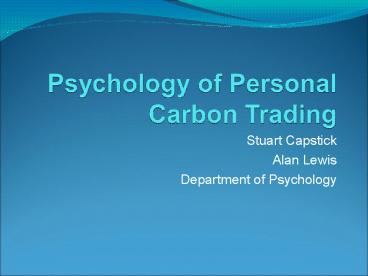Stuart Capstick - PowerPoint PPT Presentation
1 / 11
Title:
Stuart Capstick
Description:
Potential for a genuine carbon currency with financial and ... Zurich: Institute for Empirical Research in Economics. Roberts, S. & Thumim, J. (2006) ... – PowerPoint PPT presentation
Number of Views:61
Avg rating:3.0/5.0
Title: Stuart Capstick
1
Stuart Capstick Alan Lewis Department of
Psychology
2
Carbon as a parallel currency
- Lessons from other parallel currencies
- Carbon as more than a simple unit of account
- Potential for a genuine carbon currency with
financial and environmental/moral dimension
3
Introduction
- What is Personal Carbon Trading (PCT)?
- Carbon as a parallel currency
- Why Psychology?
- Visibility of carbon in PCT
- Social Psychological insights
- Behavioural economics
- Framing PCT
- Researching Psychology of PCT
- Where next?
4
Visibility of carbon
- The visibility of carbon information within PCT
may underlie many of its likely effects - Indirect evidential support that heightened
visibility in PCT could have range of effects - information provision
- goal-setting
- feedback
- learning about carbon impacts and self-efficacy
- operation in tandem with other measures
5
Social Psychology of PCT
- Changing habitual behaviours
- Opportunities to engender carbon norms?
- Crowding in vs. crowding out motivation
- Particular criticisms by Frey Stutzer (2006)?
6
Behavioural economics
- Mental accounting may lead to carbon as a
resource being treated differently under PCT than
in other scenarios - Budgeting capability
- Endowment effects
- Reference price effects
- Windfall effects
- Possibility of contradictory and complementary
ways of thinking about carbon
7
Framing PCT
- Rations vs. Entitlements
- Costs vs. Rewards
- Obligation vs. Self-efficacy
- Inconvenience vs. Simplification
- Proscription vs. Flexibility
- Restrictions vs. Collective effort
- Finance vs. morals
8
Wider issues
- Political and public acceptability of PCT
- Policy competition with taxation, upstream
trading, etc.
9
Researching Psychology of PCT
- A massive societal overhaul, at present proposed
despite almost no direct Psychological evidence - Real-life trials proposed but difficult
- Virtual trading research underway
- Surveys useful but hypothetical
- Simulations could test some cognitive claims
10
Where next?
- Whether or not PCT ever appears...
- How can carbon literacy be developed, formalised,
made visible and meaningful? - How much can the individual achieve through
carbon watching? - If not PCT, then what other means to encourage
individuals own efforts at carbon conservation?
11
References and further information
- Abrahamse et al. (2005). A review of intervention
studies aimed at household energy conservation.
Journal of Environmental Psychology, 25(3),
273-291. - Fawcett, T., Bottrill, C., Boardman, B. Lye, G.
(2007). Trialling Personal Carbon Allowances.
Oxford Environmental Change Institute. - Frey, B. Stutzer, A. (2006). Environmental
Morale and Motivation. Zurich Institute for
Empirical Research in Economics - Roberts, S. Thumim, J. (2006). A Rough Guide to
Individual Carbon Trading The ideas, the issues
and the next steps. Report to DEFRA from the
Centre for Sustainable Energy. - Seyfang, G. (2007). Personal Carbon Trading
Lessons from Complementary Currencies. CSERGE
Working Paper ECM 07-01. - Starkey, R. Anderson, K. (2005). Domestic
Tradable Quotas A policy instrument for reducing
greenhouse gas emissions from energy use. Tyndall
Centre for Climate Change Research, technical
report 39.























![❤️[READ]✔️ Back Mechanic by Dr. Stuart McGill (2015-09-30) PowerPoint PPT Presentation](https://s3.amazonaws.com/images.powershow.com/10046002.th0.jpg?_=20240603047)
![❤️[READ]✔️ Back Mechanic by Dr. Stuart McGill (2015-09-30) PowerPoint PPT Presentation](https://s3.amazonaws.com/images.powershow.com/10046850.th0.jpg?_=20240604017)
![READ⚡[PDF]✔ Back Mechanic by Dr. Stuart McGill (2015-09-30) PowerPoint PPT Presentation](https://s3.amazonaws.com/images.powershow.com/10052551.th0.jpg?_=20240611011)





